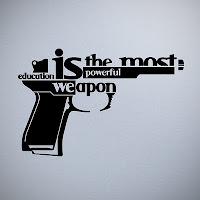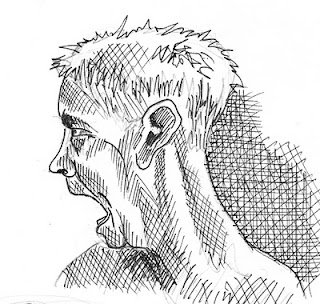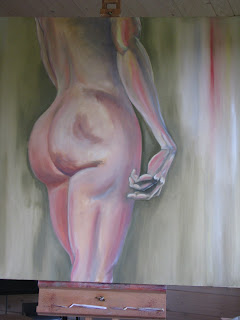Task - to read the following text and then answer questions to follow;
The room was void and unquickened; it was like a room in a shop window but larger and emptier; and the middle-aged man who sat at the desk had never thought to impress upon what he entered every day. Comfort there was none nor discomfort; only did the occupant deign to qualify the pure neutrality of his surroundings, it would surely be austerity that would emerge. The spring sunshine turned bleak and functional as it passed the plate glass of the tall-uncurtained windows.
The windows were large; the big desk lay islanded in a creeping parallelogram of light, across this and before the eyes of the man sitting motionless passed slantwise and slowly a massive shaft of shadow.
Perhaps twenty times it passed to and fro, as if outside some great joy wheel oscillating idly in a derelict amusement park. And the man rose, clasped hands behind him and walked to a window - high up in New Scotland Yard. He looked out and war-time London lay beneath... on his brow was a fixed contraction, this he had carried from desk to window, and now there was neither hardening not relaxation as he looked out... during 15 years he had controlled the file of police papers which dealt with the abduction and subsequent history of feeble minded girls. Here lay his anger as he looked out over London... year by year the anger had burst deeper until it was now the innermost principle of the man.
If this were to be made into a film what would the main character be like?
What clothes would the character be wearing?
What furniture is in the main area in which the action takes place?
I see the main character as a middle aged man, as the text says, tall, athletic, dark hair, greying at the temples. His features are strong, distinctive, and he has a clipped moustache. I've just realised that I have described Clark Gable...not sure about the moustache now.
He would be wearing a grey wool suit trousers and waistcoat. His jacket would be off, his sleeves of his white shirt rolled up, and a burgandy tie hangs loosely around his undone collar. His black overcoat and trilby hat are hanging on the hat-stand.
In the centre of the room is a large mahogany desk on which is a black telephone, in and out trays, typewriter and a leather-framed blotting pad. A brass desklamp sits on the desk and in the background is the hatstand and some metal filing cabinets.
 |
| Image search moodboard. |
In the moodboard above are images that reflect my interpretation of the story. Dark spartan offices, Dick Tracy type detectives with the hat and mac, bombed out London, 40s furniture pieces, adverts and comic books and samples of tweed patterns along with some of the colours I would like to incorporate into my pic.
Choose a word, which captures the mood you would like to convey and collect and create colours and textures to form a moodboard to give a general impression of the word.
Word brainstorm - moody, determined, frustrated, murky, dark, shady, arcane, enigmatic, bleak, cheerless, sullen, morose, ominous, dreary, unpromising, disappointed, discouraged, disheartened, embittered, angry, thwarted, simmering, INFURIATED...
Came across this interesting chapter below with reference to using colours to convey emotions etc.
Colour and Emotion in Art – Edvard Munch and Vincent van Gogh
The expression of emotions, and emotional responses, can be a central concern of artists and designers. Their aim may be to express their own emotions, to induce a particular emotional response in others, or both. Another possibility is that emotion itself might be the subject matter of a painting. Edvard Munch and Vincent van Gogh are well known for the emotional intensity of their work.
Munch described the experience which inspired his most famous painting The Scream: ‘I was walking along a road one evening… The sun went down – the clouds were stained red, as if with blood. I felt as though the whole of nature was screaming… I painted that picture, painting the clouds like real blood. The colours screamed.’. In a later painting he drew heavily on the compositional elements in The Scream to express Anxiety. An observation about Munch by his friend, the poet Sigbjorn Obstfelder, is quoted by John Gage; ‘He feels colours and he reveals his feelings through colours; he does not see them in isolation. He does not just see yellow, red and blue and violet; he sees sorrow and screaming and melancholy and decay.’
Van Gogh wrote passionately about his ideas. He regarded colour as one of the keys: ‘instead of trying to reproduce exactly what I have before my eyes, I use colour more arbitrarily, in order to express myself forcibly.’ (p.6). In letters to his brother he describes his intentions for his painting The Night Café: ‘I have tried to express the terrible passions of humanity by means of red and green’ (p.28). And then: ‘In my picture of the Night Café, I have tried to express the idea that the café is a place where one can ruin oneself, go mad or commit a crime.’ (p.31). In a letter to fellow painter émile Bernard, written from the asylum in St Rémy, van Gogh links a particular colour combination specifically to a particular emotional state: ‘this combination of red ochre, of green gloomed over by gray, the black streaks surrounding the contours, produces something of the sensation of anguish, called ‘noir-rouge’ (black-red), from which certain of my companions in misfortune frequently suffer.’
Osvaldo da Pos and Paul Green-Armytage*
Dipartimento di Psicologia Generale, Università di Padova, Via Venezia, 10-35131 Padova, Italy
*Department of Design, Curtin University of Technology, GPO Box U1987, Perth, WA 6845, Australia
continued...
 Its interesting the way your thoughts on retirement and old age swing from the positive side of things, such as more holidays, more free time and leisure, to the negative and pessimistic side which involves 'the unknown', money, ill health and the side effects of aging.
Its interesting the way your thoughts on retirement and old age swing from the positive side of things, such as more holidays, more free time and leisure, to the negative and pessimistic side which involves 'the unknown', money, ill health and the side effects of aging.  I came across these interesting and inspiring quotes which threw a more positive slant onto the subject of growing old gracefully, or maybe thats just the point, that you shouldnt have to step back into the shadows, but should carry on regardless and enjoy life to the max. This reminds me of my favourite line, which I intend to stick to;
I came across these interesting and inspiring quotes which threw a more positive slant onto the subject of growing old gracefully, or maybe thats just the point, that you shouldnt have to step back into the shadows, but should carry on regardless and enjoy life to the max. This reminds me of my favourite line, which I intend to stick to; 









































